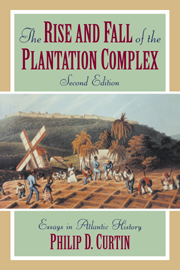6 - The sugar revolution and the settlement of the Caribbean
Published online by Cambridge University Press: 05 June 2012
Summary
For historians of the Caribbean, the “sugar revolution” usually means the seventeenth-century introduction of the whole plantation complex into the eastern Caribbean, including its technology, institutions, and the African slaves to do most of the work. “Revolution” is the right word, but that particular sugar revolution of the seventeenth century was only one among many. Each time the complex moved to a new place, it had brought on a new sugar revolution. The onward movement from Madeira to Brazil was a sugar revolution; the forward movement from the eastern Caribbean to Saint Domingue and Jamaica after 1700 was another; and still others lay in the future for Cuba, Mauritius, Natal, Peru, Hawaii, and Fiji – among others. The sugar revolution in the eastern Caribbean, however, was especially significant. It continued the institutional and economic patterns already developed in Brazil, but this new version of the plantation complex was more specialized, more dependent on networks of maritime, intercontinental communication. It was also an important step into the North Atlantic, and it was, incidentally, the stepping stone that was to bring the African slave trade and a peripheral version of the plantation complex to the United States.
Caribbean geography
The Caribbean islands are far more diverse than might be expected. A number of variables joined to make any one of them especially valuable at seventeenth-century levels of technology.
Soil is obvously important, and several of these islands have fine volcanic soils, but the most valuable volcanic soils are concentrated in only a few square miles – not in regions as large as the whole of one of the Greater Antilles.
- Type
- Chapter
- Information
- The Rise and Fall of the Plantation ComplexEssays in Atlantic History, pp. 73 - 85Publisher: Cambridge University PressPrint publication year: 1998

